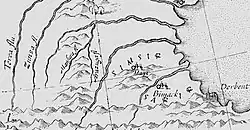Timurid invasion of Simsim
Timurid invasion of Simsim happened in the 14th century when the Timurid Empire invaded Simsim, an ally of the Golden Horde. As a result, Simsim was devastated which lead to the collapse of the state itself; the population was killed while the churches and temples were destroyed.
| Timurid invasion of Simsim | |||||||
|---|---|---|---|---|---|---|---|
| Part of Tokhtamysh–Timur war | |||||||
 Medieval map of Simsim | |||||||
| |||||||
| Belligerents | |||||||
| Simsim |
Muhammad[lower-alpha 2] | ||||||
| Commanders and leaders | |||||||
| Gayur Khan |
| ||||||
Background
In 14 April 1395, the forces of Golden Horde under Tokhtamysh and Timurid Empire under Timur met on the opposite sides of the Terek River in the Battle of the Terek River. Both armies counted around 300,000 men. The native North Caucasians participated on the side of Tokhtamysh. Timurids won over the Golden Horde and Tokhtamysh's army was dispersed.[1] Pursuing Tokhtamysh, Timur annihilated and robbed on the way Bulgaria, Kievan Rus' and Crimea. Having returned to North Caucasus, he carried out a massacre of the local people.[2]
Invasion
After the destruction of the Kapchigai Fortress, Timur returned back to the Pyatigorye, his headquarters. There he let his army rest and planned another invasion to the North Caucasus, this time, to Simsim.[3] According to Abd al-Razzaq Samarqandi, Timur declared to the population of Simsim that "anyone who obeyed would be pardoned, and anyone who resisted would be executed". However, this threat was ignored by the population of Simsim to which followed the invasion of Timur.[4]
Timur arrived in Simsim and son of Gayur Khan, Muhammad, defected to Timur together with his ilem ('region and subjects') and became Timur's vassal. The lowland Muslim Turkic inhabitants of Simsim gave little to no resistance to Timurids and submitted easily.[5]
The invasion took on a large scale as attested by the fact that Timur's court historians did not consider it necessary to describe the fate of Gayur Khan, but focused all their attention on Timur's actions in the mountainous Simsim.[1]
Timurids invaded the mountainous Simsim not only because the inhabitants of Simsim retreated to there, but also because of the pagan beliefs of the inhabitants.[5] Timurids divided into separate units and moved through the mountainous Simsim from west to east, capturing and destroying fortresses and castles along the way, located mainly in the modern day Dzheyrakhsky and Galashkinsky Districts of Ingushetia and Galanchozhsky, Shatoysky and Itum-Kalinsky Districts of Chechnya. After the fighting in the Argun Gorge, Timurids turned to the northeast, delving into the forest zone of the current Sharoysky, Vedensky and Nozhay-Yurtovsky Districts up to the Andian Ridge. By order of Timur, the inhabitants of mountainous Simsim were tied and thrown off cliffs while their churches and temples were ruined and destroyed.[1]
During the fighting in Simsim, Timurids took control of many regions and areas. Timur desired so much to deal with the rebellious mountaineers that he even ordered his army to climb into places from which neither horse nor foot could descend. Focusing on the strength of resistance of the inhabitants of Simsim, the ferocity of military operations in the most difficult mountain conditions, Timur's court historians noted that Timur himself "was subjected to these horrors and dangers".[1]
Aftermath
As a result of the Timurid invasion, the Simsim state dissolved.[6]
Notes
- Simsim has been localized in Ichkeria (Chechnya), Checheno-Ingushetia and sometimes, in both Ichkeria and Kumyk Plain. See Simsir § Localization.
- Son of Gayur Khan; defected to the side of Timur during the Timurid invasion. See § Invasion.
References
- Khizriev 2019.
- Khizriev 1992, p. 66.
- Khizriev 1992, p. 85.
- Khizriev 1992, p. 87.
- Rtveladze 1976, p. 119.
- Velikaya et al. 1990, p. 19.
Bibliography
English sources
Russian sources
- Rtveladze, E. V. (1976). "О походе Тимура на Северный Кавказ" [About Timur's campaign in the North Caucasus]. In Vinogradov, V. B. (ed.). Археолого-этнографический сборник: вып. 4 [Archaeological and ethnographic collection: no. 4] (in Russian). Grozny. pp. 103–128.
{{cite book}}: CS1 maint: location missing publisher (link) - Khizriev, Kh. A. (1992). Iriskhanov, I. A. (ed.). Кавказцы против Тимура (Борьба народов Северного Кавказа против экспансии Тимура) [Caucasians against Timur (The struggle of the peoples of the North Caucasus against the expansion of Timur)] (in Russian). Grozny: Kniga. pp. 1–168. ISBN 5-7666-0320-7.
- Khizriev, Kh. A. (2019). "Нашествие Тимура и борьба чеченцев за независимость" [The invasion of Timur and the struggle of the Chechens for independence] (in Russian). Grozny: AN ChR.
- Velikaya, V. N.; Vinogradov, V. B.; Khasbulatov, A. I.; Chakhkiev, Yu. D. (1990). Aliroev, I. Yu. (ed.). Очерки этнографии чеченцев и ингушей (in Russian). Grozny: Chech.-Ing. gos. un-t. pp. 1–93.
Further reading
- Khizriev, Kh. A. (1977a). "Из истории борьбы народов Чечено-Ингушетии и Ставрополья против Тимура" [From the history of the struggle of the peoples of Chechen-Ingushetia and Stavropol against Timur]. Вопросы истории Чечено-Ингушетии [Issues of the history of Checheno-Ingushetia] (in Russian). Vol. 11. Grozny: Chech.-Ing. kn. izd-vo. pp. 11–25.
- Khizriev, Kh. A. (1977b). "Из истории борьбы народов Чечено-Ингушетии и Ставрополья против Тимура" [From the history of the struggle of the peoples of Chechen-Ingushetia and Stavropol against Timur]. Вопросы истории Чечено-Ингушетии [Issues of the history of Checheno-Ingushetia] (in Russian). Vol. 11. Grozny: Chech.-Ing. kn. izd-vo. pp. 25–40.